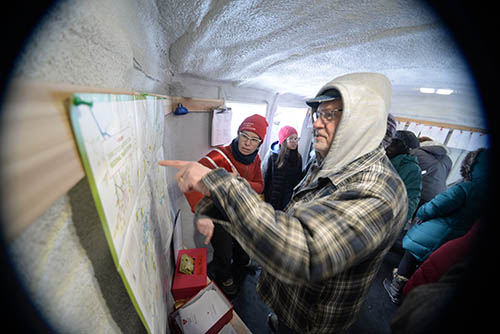When does love grow a forest and build climate change resilience?
When you visit the Met Council’s Future Forest Art Shanty at Lake Harriet on weekends, January 18 – February 9, during Art Shanty Projects 2020.
Visitors to the bright red shanty are invited to write a short love letter to their favorite regional park. For every five visitors who write a letter, another tree will be planted at Crosby Farm Regional Park in Saint Paul. Research is under way in the park to identify climate-resilient tree species for Minnesota’s future climate.
“Public art is a really great way to tell the story of science and conservation,” said Mary Hammes of Mississippi Park Connection. “Imagination is needed to create a vision of a successful future.”
Mississippi Park Connection, the nonprofit partner of the Mississippi National River and Recreation Area, is collaborating with several organizations to address climate change in the Mississippi River’s floodplain forests. Learn about Adaptive Silviculture for Climate Change.
Raising awareness of the 56 regional parks and 400 miles of connecting trails
In addition to contributing to the research project, the Met Council’s art shanty is designed to raise awareness of the regional park system and welcome audiences who may not see themselves in the way park signage is designed, said Amanda Lovelee, artist and regional parks ambassador for the Met Council.
 “What better billboard for the regional parks than a bright red shanty in the middle of the lake,” Lovelee said. “Many people will be visiting the 20 art shanties to experience arts and culture, not necessarily to be outside. This is a great opportunity to expand our audience.”
“What better billboard for the regional parks than a bright red shanty in the middle of the lake,” Lovelee said. “Many people will be visiting the 20 art shanties to experience arts and culture, not necessarily to be outside. This is a great opportunity to expand our audience.”
Volunteers in the Council’s shanty will answer questions about the regional parks, all the activities available in the parks, and how we care for parks. They will also talk about the importance of the urban tree canopy in creating climate resilience and the function of trees in fighting climate change.
Welcoming all people into the regional parks
Lovelee partnered with Filipino artist Witt Siasoco to commission an indigenous artist and three artists of color (in addition to Siasoco) to design flags that will be hung on a pole at the corner of the shanty.
“As a person of color, I don’t see many advertisements speaking directly to non-white audiences,” Siasoco said. “So when I designed the flag, I wanted to make sure that people of color were figuratively and literally at the center of the image.
“One of my favorite things to do at a regional park is to simply hang a hammock and hang with my family,” he said. “I find this to be a universal activity and one that would speak to many others.”
“Parks mean a lot to me,” he said. “Fresh air and access to open space is crucial to our mental and physical health. Parks are a great place to be with my family.”
 Pairing artists with park agencies
Pairing artists with park agencies
The artists were invited to a half-day workshop at a regional park to learn about the park system and examine how signage has traditionally been done.
“The typical aesthetic in the park system is a very one-sided story, and just one story of what nature can be,” Lovelee said. “Instead of the typical green and brown signs and benches, what if we painted all the benches in a park in rainbow colors?
“Many cultures use colors in significant ways that are different than white culture, which has dominated park interpretation,” she said. “How do we help people see themselves in our parks?”
In 2020, each of the commissioned artists will be paired with a regional park agency to build relationships and work together on how to better welcome visitors.
Future Forest Art Shanty will find a home with Ramsey County Parks
Once the Art Shanty Project is complete, Lovelee said, the Ramsey County Parks & Recreation Department will adopt the Met Council shanty and use it for activities from teaching ice fishing skills to pop-up engagement in other seasons.
In the fall, the Met Council and Mississippi Park Connection will cohost a “Tea Time, Tree Time” event to welcome the new tree residents to the region. University of Minnesota researchers will be on hand to answer questions about the project.
More about regional parks